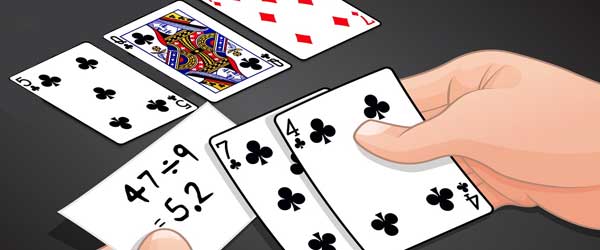If you expect to make a profit as a poker player, and eventually become a serious poker player, poker odds will have to become a pretty big part of your poker game.When a big decision needs to be made, poker odds play a big part in what is likely to happen, what is unlikely to happen, and what perchance has already happened.
Interesting Poker Odds
Did you know that according to poker math and statistics, you have a 0.45% chance of being dealt pocket aces preflop. That’s just trivia though, the odds that will actually help you win more money playing poker are calculations that take into consideration what you have, and what you’ll need to win, versus what your opponent has, and what he/she needs to win.In this article you will learn more about how to calculate the odds according to the number of outs if you have that will make your own hand stronger.As you learn different percentages, try to memorize a few of the basic numbers, so that you can recall them during play. If it helps, get yourself something round, and decorate it with some of the more percentages.
What are the odds that you’ll flop a set if you have a pair preflop?
If you have a pocket pair, your chance of flopping trips or better is 11.8% as long as you have no reason to know that no one folded one of your out. For instance, let’s say you have a pocket pair of aces. You raise preflop, and someone folds, tossing his cards toward the dealer. You see an ace flash, well that changes everything. None of the calculations you’re about to read will be accurate.In most cases, that’s not going to happen though, and your chances of flopping trips are 7.5/1 or 11.8%.What are the odds that you’ll flop a flush with 2 suited cards?
Let’s say you have nothing better than 6Q of spades and are hoping to flop a flush. Hey, it’s possible right?It sure is! But just how possible is it? Is it merely possible, or is probable? Your chances of actually flopping the flush when you’re holding 2 suited cards are 117.79 to 1 according to homepokergames.com. That’s .84%. Not 84% but .84%. You have less than a 1% chance of flopping a flush when you’re holding two suited cards.So how did they get there? Not counting the two cards that you’re holding in your hand, there are 50 cardsremaining in the deck, or other players hands. That’s 50 unidentified cards. Not counting the 2 spades that you hold, 11 remain unaccounted for. So we have 50cards/11spades multiplied by 49/10 multiplied by 48/9.That doesn’t mean you shouldn’t ever keep suited cards, you just need a little something better. Let’s say for instance you’ve got Ten-Jack of diamonds, so you’ve got suited and connected cards, that could make a straight, or could make a flush. Your chance of flopping 2 of your flush cards, for a flush draw are 43.5 to 1 or 2.24%, slightly better, but still nothing to write home about.If one of your cards paired the other card though, or you have at least an ace, or a straight draw to go with your flush draw, then you’re adding to your outs, and making your way toward making a strong hand by the river. Just keep in mind, even if you flop that flush, your chances of making that flush by the river are only 15/1. It’s possible, it happens plenty often, but it is actually not probable.
Pot odds in Poker Games
Pot odds is a way to describe how big a pot is compared to the money or poker chips that you will have to invest to have a chance to win the pot. This is also written as 1:X.The 1 is the bet and X is the number of bets that the pot consists of. If you have to invest one dollar for a chance to win four dollars your pot odds are 1:4.If you invest three dollars to win a six dollars pot your pot odds are 1:2 a six dollars pot equals two of your bets. A three dollars bet for a nine dollars pot gives the pot odds of 1:3 and so on.So if you keep the things we talked about above in mind, and start to learn quick facts like, the fact that you have a 38.6% of winning a hand where flop a flush draw, and your opponent flops top pair. Then you use those poker odds together with pot odds to evaluate whether or not calling a bet will pay off in the long run, and whether the risk is worth the possible return.

